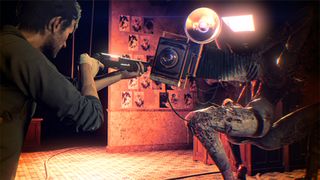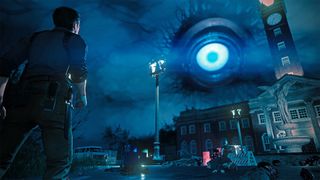The Evil Within 2 hands-on: more open horror forces you to make tough choices
Familiarly grim and challenging horror.

The first thing I notice about The Evil Within 2 is that it doesn't feature the first game's memorable, albeit largely divisive, letterbox visual setting by default. "You can actually turn this on if you want," a Bethesda rep tells me during my hands-on time at Gamescom. "It's just that most people didn't like it the first round."
I'm hightailing it down a narrow, dimly lit corridor from an unsightly beast with multiple disfigured heads, a gore-soaked and exposed spinal cord, and a rotating saw blade for a hand. This definitely feels like The Evil Within. It took me some time, but I eventually warmed to the 2014 scare 'em up, which paid closer deference to the work of Team Silent than director Shinji Mikami's own Resident Evil. The Evil Within 2 is a similar deal, but a couple of key additions suggest it could be a better game.

Protagonist Sebastian Castellanos' daughter, once thought dead, is seemingly still alive, and this drives the second game's story. We return to a similar, though more exploration-friendly, world. My first experience of the game's less linear structure comes via a Silent Hill-esque boulevard that's adorned with abandoned buses, misplaced train carriages and broken down cars.
Swarms of The Haunted stalk every corner and, having acquired a communication device (which leads him to his daughter and doubles up as a map), Castellanos sets off to navigate the hostile layout while laying waste to beasts along the way.

My first attempt at negotiating the less-than-welcoming crowd sees me cowering behind whatever cover I can find, before picking off foes one-by-one in stealth mode. In a bid to distract a bigger group up ahead, a misdirected bottle alerts one undead soul to my whereabouts. Several shots later and I've in turn attracted another three. A well-placed oil drum allows me to dispose of the initial pursuer but after prematurely emptying my revolver it's not long before the other two are feasting on my neck.
Despite Mikami's (possibly mistranslated) suggestion that players should choose the game's Casual setting, we're advised to try Nightmare mode, which adds an expected but appropriate degree of challenge to what might be familiar to returning players.

This difficulty becomes apparent during my second attempt. Instead of journeying through the section's more exposed thoroughfare, I vault a fence and attempt to circumvent my assailants. Doing so nets me a laser-sighted pistol and a stockpile of gunpowder—The Evil Within 2 now has a crafting system, which allows players to sculpt weapon enhancements and ammo among other things—but leads me into a park teeming with enemies. I draw three out from the horde, deal with them one-by-one in cover, and then get caught by an irradiated monstrosity who spews acid over my head, melting my skin and exposing the gore and gristle beneath my face. The horror.
PC Gamer Newsletter
Sign up to get the best content of the week, and great gaming deals, as picked by the editors.

Granting players more than one plan of attack in any given situation is a bold move for The Evil Within, but one which pays dividends in light of the first game's more restrictive makeup. From the small segment I've played, you could argue this dilutes the original's sense of claustrophobia, but there's a real tension in being forced to make decisions. Choosing a path which plays to your own strengths is vital and, despite dying more than I'd like to admit, I appreciated abandoning one strategy in favour of another and seeing these events play out so differently.
I'm interested to see how these branching pathways play out deeper into the game with more varied enemy types, but I'm pretty convinced this design decision is good for The Evil Within 2. With the crafting system and unlockable upgrades that allow customisation of Sebastian's stats, like Stealth, Recovery and Combat, there's a strong chance this will be an improved sequel—one that retains the engagingly oppressive tone of the first game.
Most Popular

